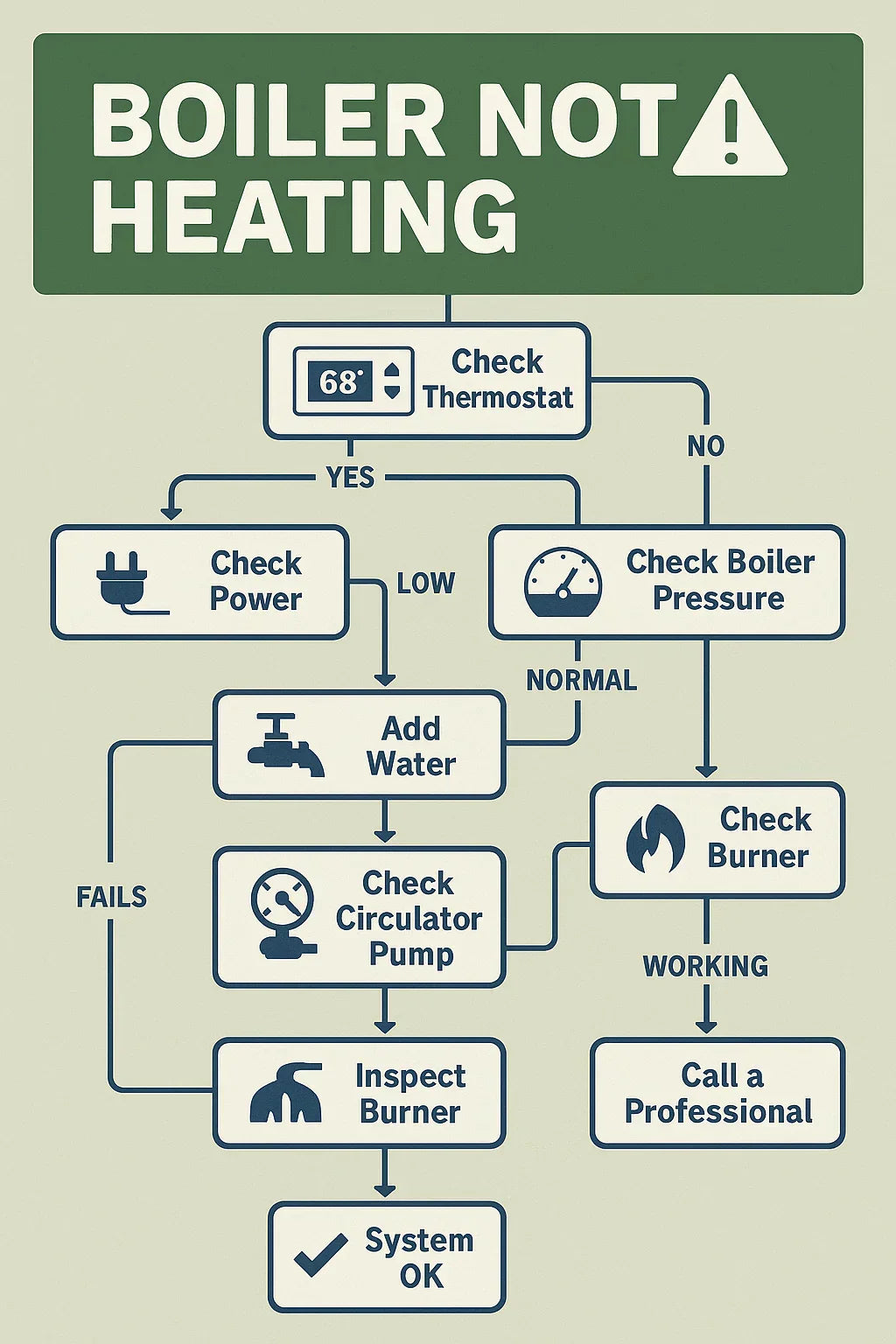I’ll never forget the first time my Weil-McLain CGA-6 boiler stopped heating my home in the middle of a Pennsylvania winter. My family was freezing, and I was already imagining thousands of dollars in repair bills.
But here’s the truth: not every “no heat” scenario is a disaster. Sometimes the problem is as small as a tripped breaker, air in the radiators, or a thermostat set to the wrong mode.
This guide walks you through a step-by-step troubleshooting process you can use when your Weil-McLain CGA-6—or any gas boiler—isn’t heating properly. I’ll share not just the technical fixes but also my real-world lessons learned, so you can avoid the mistakes I made.
🟢 Step 1: Start with the Basics
✅ Check thermostat settings
-
Make sure the thermostat is set to HEAT and the temperature is above room temperature.
-
If it’s programmable, ensure schedules aren’t overriding manual settings.
💡 My mistake: I once spent an hour fiddling with the boiler only to discover my teenager had lowered the thermostat to 60°F.
✅ Check power supply
-
Verify the boiler’s switch is on (looks like a light switch near the boiler).
-
Inspect your home’s breaker box. A tripped breaker is a common culprit.
✅ Check gas supply
-
Ensure the gas valve to the boiler is open.
-
If you smell gas → STOP immediately and call your utility emergency line.
🔗 DOE – Heating Troubleshooting Basics
🟡 Step 2: Inspect Boiler Pressure and Temperature
The CGA-6 typically runs at:
-
12–15 psi cold
-
15–20 psi hot
If pressure is too low:
-
Check the automatic fill valve (may need adjustment).
-
Look for leaks in piping or the expansion tank.
If pressure is too high:
-
The expansion tank may be waterlogged.
-
Relief valve should open at 30 psi—if it doesn’t, call a pro.
🔗 HeatingHelp – Pressure Issues Explained
🔵 Step 3: Bleed Radiators and Check for Airlocks
Symptoms of trapped air:
-
Radiators warm on bottom but cold on top.
-
Gurgling or banging noises in pipes.
How to bleed radiators:
-
Turn off the system.
-
Place a container under the radiator bleed valve.
-
Use a radiator key to open slightly until water (not air) comes out.
-
Close and check boiler pressure again.
💡 Samantha’s lesson: Skipping seasonal bleeding once caused half my second floor to feel like an icebox until I fixed it.
🔗 BobVila – How to Bleed Radiators
🟠 Step 4: Check Circulator Pumps and Zone Valves
The Weil-McLain CGA-6 can run multiple zones. If one area of your home is cold:
-
Circulator pump issue
-
Loud grinding = bad bearings.
-
Pump hot but no flow = seized impeller.
-
-
Zone valve issue
-
Thermostat calls for heat but valve doesn’t open.
-
You can feel if the pipe beyond the valve stays cold.
-
👉 In my case, one winter the upstairs was freezing while the downstairs was fine. The culprit? A stuck zone valve—$200 repair, not a whole new boiler.
🔗 Caleffi Hydronics – Zoning Explained
🔴 Step 5: Test Safety Controls
Boilers come with several safety devices that shut things down when there’s a problem.
-
Pressure relief valve: Should release water if pressure hits 30 psi.
-
Low-water cutoff: Prevents dry firing. Test by slowly draining water until it triggers shutoff.
-
Flame sensor/thermocouple: Dirty or failed sensors prevent ignition.
👉 If your boiler won’t fire at all, the flame sensor could be dirty—a $20 DIY clean instead of a $300 service call.
🟣 Step 6: Look for Leaks
-
Water leaks: Puddles near boiler could indicate:
-
Leaky relief valve
-
Failed expansion tank
-
Corroded fittings
-
-
Gas leaks: Rotten egg smell = natural gas leak. Shut off immediately and call your utility emergency line.
🟤 Step 7: When to Call a Pro
DIY stops here if you notice:
-
Repeated short-cycling (boiler turns on/off every few minutes).
-
No ignition after resets.
-
Cracked heat exchanger (visible water leaks inside boiler sections).
-
Electrical board failure.
💡 Samantha’s rule: If I’ve checked the basics and the boiler still won’t heat, I call my HVAC pro. Safety first with gas appliances.
🧾 Common Problems & Quick Fixes
| Symptom | Likely Cause | DIY Fix | Pro Needed |
|---|---|---|---|
| No heat at all | Thermostat/power issue | Yes | Sometimes |
| Some rooms cold, others warm | Zone valve stuck | Maybe | Usually |
| Radiators partly cold | Air trapped | Yes | No |
| Boiler pressure too low | Fill valve issue/leak | Maybe | Often |
| Strange banging noises | Airlocks/water hammer | Yes | No |
| Pilot won’t light/stay lit | Thermocouple/flame sensor | Clean | Replace |
| Repeated shutdowns | Control board/safety device | No | Yes |
🧑🔧 Samantha’s Real-World Lessons
-
The $0 fix: Once, no heat was just a tripped breaker. Reset = warm house again.
-
The $50 fix: My flame sensor needed cleaning. A little emery cloth saved me a service call.
-
The $200 fix: A stuck zone valve kept my office cold—pro replaced it in under an hour.
-
The $1,200 scare: A neighbor ignored small leaks; by the time he called for help, the heat exchanger cracked and he needed a full replacement.
✅ Key Takeaways
-
Start with simple checks: thermostat, breakers, gas valve.
-
Watch boiler pressure and temperature carefully.
-
Bleed radiators each season to avoid cold spots.
-
Circulator pumps and zone valves are common weak points.
-
Know when to stop—gas leaks, cracked exchangers, or repeated shutdowns = call a pro.
💡 Samantha’s advice: The CGA-6 is built to last, but even the best boiler needs attention. Troubleshooting early can save you thousands and keep your family warm.
In the next topic we will know more about: Weil-McLain vs. Burnham vs. Slant/Fin: Which 166,000 BTU Gas Boiler Should You Choose?







